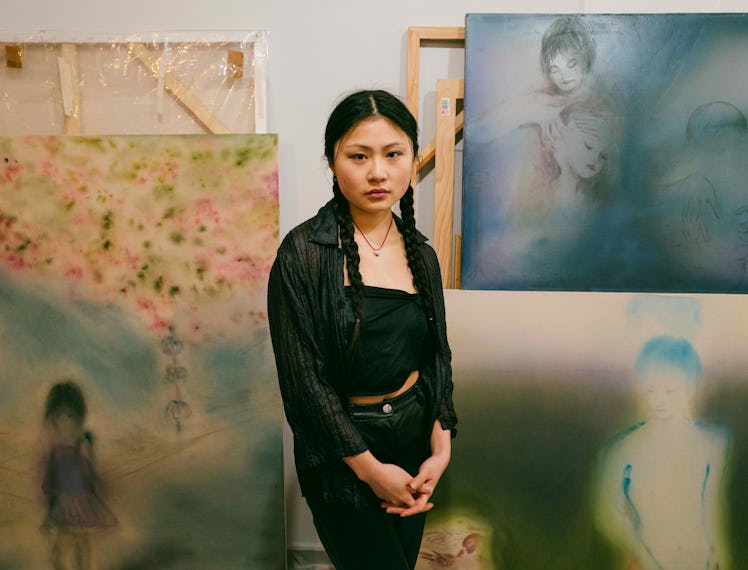It has only been three months since Xingzi Gu (who uses they/them pronouns) completed their MFA at New York University and moved into their first, official studio in Dumbo, Brooklyn, yet the industrial space already houses a lifetime of painting. Xingzi’s dreamy, richly colored canvases tenderly weave melancholy and decadence, mined from her youth in the ancient city of Nanjing, the capital of the Jiangsu province of the People’s Republic of China. Comprising ten coats of acrylic pigment and even more layers of nostalgic complexity, the washy paintings can take over a year to complete, while others coalesce in days.
The effect is both quixotic and vivid. At 28, the artist still glides under the art world radar, although not for long. This month, Xingzi presents a suite of nine new works, Pure Heart Hall, their debut solo show at Lubov gallery in Chinatown, on view from April 27 to June 9. May brings another inflection point: a two-artist exhibition at Lubov’s booth for New York’s Independent Art Fair—an event curators and collectors rely on for breakout stars.
“This is a picture of two young men, but I don’t want to paint them too masculine, so I try to play around and make it more ambiguous,” says Xingzi, surveying a deeply saturated, romantic tableau of hazy blue dots emanating from an androgynous couple entangled on a beach towel. The painting took three months to create and will appear in the gallery debut. “It requires a lot of concentration and energy, because once you stain the canvas, you can’t go back. I can’t let the red, for example, bleed into the body because it’s supposed to be the background,” they explain. “It’s a very tender moment and the bubbles feel like goosebumps or tingles that I’m trying to capture. When I make a painting, I have to think about how a moment would feel.”
For the artist, the compositions are “a kind of capsule of time or memory or emotion;” their subjects are inspired by film stills, book covers, and online images, with a heavy dose of imagination. In one case, a girl-on-a car hood advertisement is recast in the spirit of French Modernist Édouard Manet’s iconic nude Olympia, so the lounging model appears classically rendered, less dramatized. According to Margaret Kross, who was on the 2022 Whitney Museum Biennial curatorial team and is writing exhibition text for Pure Heart Hall, Xingzi’s paintings of “breathy landscapes” and “psychic pools of silky pastels” imagine a version of girlhood and adolescence in a soft universe where there is permission to access private emotions.
Xingzi Gu, Rouge, 2024
“I have always been painting figures in this manner,” explains Xingzi. “They’re intimate and a little erotic, but also a little bit toxic and dangerous. I’m trying to capture innocence when it becomes kind of not innocent anymore.” Indeed, some of the artist’s source material plumbs darker coming-of-age terrain. One canvas draws on the 2001 experimental Japanese film All About Lily Chou-Chou, which centers a vicious junior high school bully, ultimately killed by a classmate; in another, a girl is dressed as a character in Kill Bill.
Raised by two struggling painters in Nanjing, in what the artist calls a mixed working and middle-class family, her parents toggled odd jobs while trying to maintain their art practice. The artist recounts a formative, messy home studio as a playground for experimenting with painting, collage, and sculpture. Financial support for Xingzi’s formal art education came from Xingzi’s grandmother and uncle, who ran a toy and textile factory nearby. “I mostly grew up without any steady income,” they say. “But my grandma stepped in to help and my life changed. Suddenly, I could access international education. It was a strange transition.” Before coming to Manhattan, Xingzi earned a BFA at the School of the Art Institute of Chicago, following a year at the Elam School of Fine Arts in Auckland, New Zealand to study English and graphic design, and a student exchange year at Stony Brook University on Long Island.
Nanjing was the scene of a horrific massacre during the Sino-Japanese war at the end of 1937 and beginning of 1938, which left between 200,000 and 300,000 dead; thousands of women and girls were raped. This history haunts Xingzi, who returned to China for three years after the Art Institute of Chicago and a total of a decade studying abroad. “As a ten-year-old, we would go visit the memorial for the Nanjing massacre. That was just a school day trip,” they recall. “There’s always a discomfort. Nanjing has a heavy history and a solemn seriousness or gloominess. In contrast, there’s a sense of indulgence bred by the temperate climate and scenery. There’s a real contradiction to the city—similar to my paintings.”
Eastern medicine also informs their visual language of half-imagined worlds and abstract melancholia. “The Western approach to the human body is through anatomy and science, opening your muscles and organ structure,” says Xingzi. “But Eastern healing is about your chi, the energy and the yin-yang balance. I understand the body in totally different ways.” Accordingly, when you represent a figure from a Western perspective, you paint the musculature, whereas in Eastern tradition, Xingzi says, “you paint the aura and the energy, or the balance in that specific person, the chi compass element.”
Xingzi Gu, Lili Pond, 2024
Lately, Xingzi has been preoccupied with the literary genre of bildungsromans by modern Chinese novelists like Su Tong and Yu Dafu, whose youthful protagonists encounter a society that corrupts their moral and intellectual desires. “I paint with a lot of intuition and what I feel at the present time or day,” Xingzi says. “I am capturing a lot of emotional things that aren’t rational ideas. I do have a strange feeling that my painting is from the past or my memory of painting is always in the last generation, somehow.”
